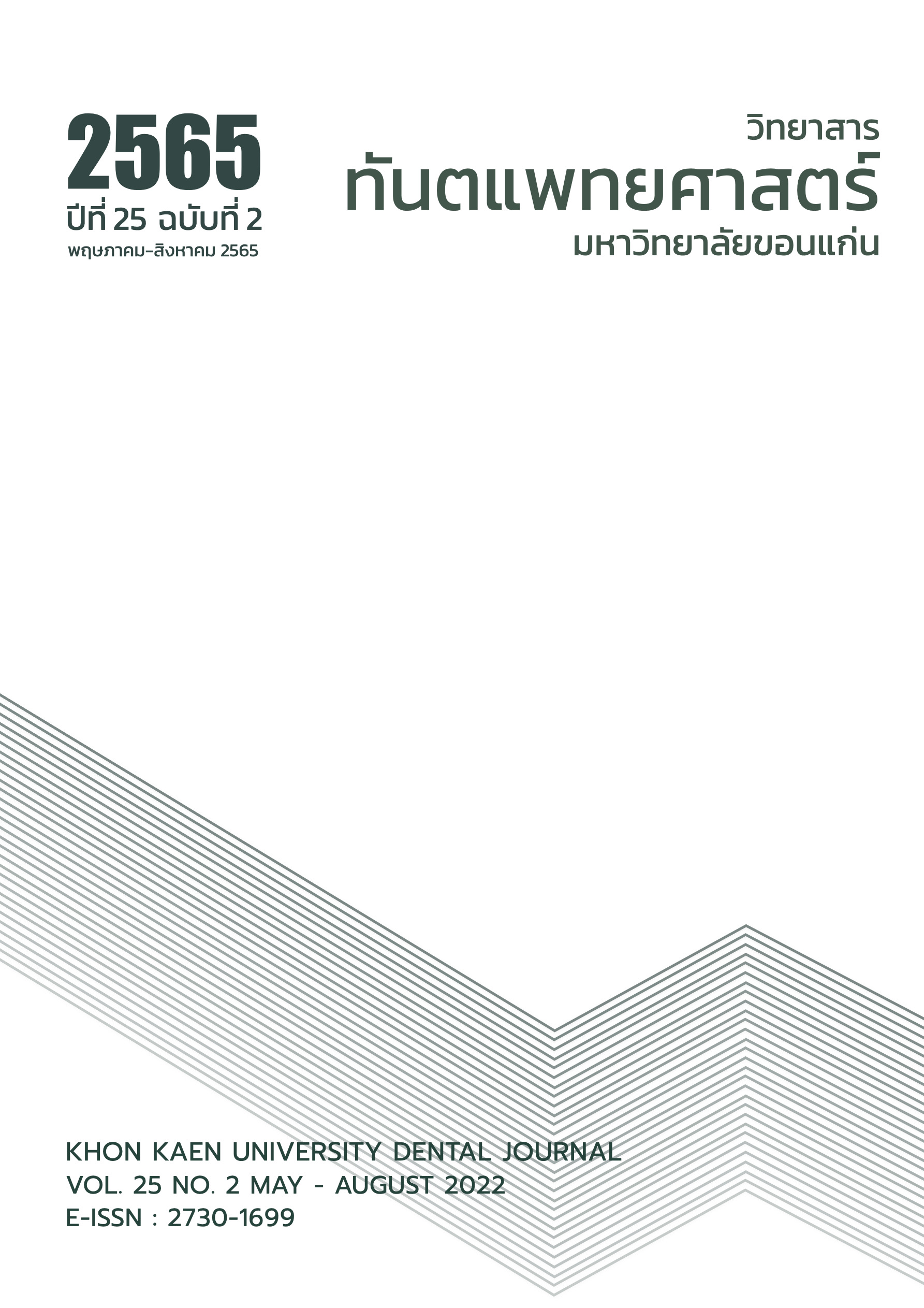การพบคลองรากฟันด้านแก้มใกล้กลางที่สองของ ฟันกรามแท้บนซี่ที่หนึ่ง โดยวิธีถ่ายภาพรังสีส่วนตัดอาศัยคอมพิวเตอร์ชนิดโคนบีมและการย้อมสีคลองรากฟัน
Main Article Content
บทคัดย่อ
การศึกษานี้มีวัตถุประสงค์เพื่อศึกษาการพบคลองรากฟันด้านแก้มใกล้กลางที่สอง ในฟันกรามแท้บนซี่ที่หนึ่งในประชากรภาคตะวันออกเฉียงเหนือของประเทศไทย ที่ถูกถอนจำนวน 81 ซี่ โดยเปรียบเทียบประสิทธิภาพในการหารูเปิดคลองรากฟันภายหลังการเตรียมช่องเปิดเข้าสู่โพรงเนื้อเยื่อในฟันระหว่างการดูด้วยตาเปล่าและการดูภายใต้กล้องจุลทรรศน์ และเปรียบเทียบประสิทธิภาพในการหาคลองรากฟันด้านแก้มใกล้กลางที่สอง ระหว่างวิธีการถ่ายภาพรังสีส่วนตัดอาศัยคอมพิวเตอร์ชนิดโคนบีมและวิธีการย้อมสีคลองรากฟัน พบว่า ความชุกของการพบคลองรากฟันด้านแก้มใกล้กลางที่สองด้วยวิธีการเตรียมช่องเปิดเข้าสู่โพรงเนื้อเยื่อในฟันด้วยวิธีการดูด้วยตาเปล่า วิธีการส่องกล้องจุลทรรศน์ วิธีการถ่ายภาพรังสีส่วนตัดอาศัยคอมพิวเตอร์ชนิดโคนบีม และวิธีการย้อมสีคลองรากฟันพบคลองรากฟัน ด้านแก้มใกล้กลางที่สองอยู่ที่ร้อยละ 19.75, 48.15, 79.00 และ 67.90 ตามลำดับ เมื่อหาความสัมพันธ์ของการหาคลองรากฟันด้านแก้มใกล้กลางที่สองระหว่างวิธีการดูด้วยตาเปล่าและวิธีส่องกล้องจุลทรรศน์ พบว่าระดับความสัมพันธ์ทางบวกระดับสูงถึงสูงมาก (rs=0.515) ความสัมพันธ์ระหว่างวิธีถ่ายภาพรังสีส่วนตัดอาศัยคอมพิวเตอร์ชนิดโคนบีมและการย้อมสีคลองรากฟันในคลองรากฟันส่วนต้นและส่วนกลาง พบระดับความสัมพันธ์ทางบวกระดับสูงถึงสูงมาก (rs=0.611, rs=0.523) และในคลองรากฟันส่วนปลาย พบระดับความสัมพันธ์ทางบวกระดับปานกลางถึงสูง (rs=0.479) ค่าความสัมพันธ์โดยรวม พบระดับความสัมพันธ์ทางบวกระดับปานกลางถึงสูง (rs=0.490) จากผลการศึกษาแสดงให้เห็นว่าการใช้กล้องจุลทรรศน์ในการหาคลองรากฟันด้านแก้มใกล้กลางที่สอง มีประสิทธิภาพสูงกว่าวิธีการดูด้วยตาเปล่า และเมื่อพิจารณาระดับความสัมพันธ์ในการหาคลองรากฟันด้านแก้มใกล้กลางที่สองระหว่างวิธีถ่ายภาพรังสีส่วนตัดอาศัยคอมพิวเตอร์ชนิดโคนบีมและการย้อมสีในคลองรากฟัน แสดงให้เห็นว่าประสิทธิภาพในการหาคลองรากฟันด้านแก้มใกล้กลางที่สองของวิธีถ่ายภาพรังสีส่วนตัดอาศัยคอมพิวเตอร์ชนิดโคนบีมใกล้เคียงกับวิธีย้อมสีคลองรากฟัน ดังนั้นการถ่ายภาพรังสีส่วนตัดอาศัยคอมพิวเตอร์ชนิดโคนบีมจึงเป็นทางเลือกที่ดีในการหาคลองรากฟันด้านแก้มใกล้กลางที่สองในทางคลินิก
Article Details

อนุญาตภายใต้เงื่อนไข Creative Commons Attribution-NonCommercial-NoDerivatives 4.0 International License.
บทความ ข้อมูล เนื้อหา รูปภาพ ฯลฯ ทีได้รับการลงตีพิมพ์ในวิทยาสารทันตแพทยศาสตร์ มหาวิทยาลัยขอนแก่นถือเป็นลิขสิทธิ์เฉพาะของคณะทันตแพทยศาสตร์ มหาวิทยาลัยขอนแก่น หากบุคคลหรือหน่วยงานใดต้องการนำทั้งหมดหรือส่วนหนึ่งส่วนใดไปเผยแพร่ต่อหรือเพื่อกระทำการใด ๆ จะต้องได้รับอนุญาตเป็นลายลักษณ์อักษร จากคณะทันตแพทยศาสตร์ มหาวิทยาลัยขอนแก่นก่อนเท่านั้น
เอกสารอ้างอิง
Witherspoon DE, Small JC, Regan JD. Missed canal systems are the most likely basis for endodontic retreatment of molars. Tex Dent J 2013;130(2): 127-39.
Qian WH, Hong J, Xu PC. Analysis of the possible causes of endodontic treatment failure by inspection during apical microsurgery treatment. Shanghai Kou Qiang Yi Xue 2015;24(2):206-9.
Neeta S, Charu G. Methods to study root canal morphology: A review. Endodontic Practice Today 2012;6(3):171-82
Alavi AM, Opasanon A, Ng YL, Gulabivala K. Root and canal morphology of Thai maxillary molars. Int Endod J 2002;35(5):478-85.
Lee JH, Kim KD, Lee JK, Park W, Jeong JS, Lee Y, et al. Mesiobuccal root canal anatomy of Korean maxillary first and second molars by cone-beam computed tomography. Oral Surg Oral Med Oral Pathol Oral Radiol Endod 2011;111(6):785-91.
Drs. Paul Krasner, Henry J. Rankow, Edward S. Abrams. Endodontics: colleagues for excellence access opening and canal location. 1sted. Chicago: Spring; 2010.1-8.
Pablo B, Pablo N, Mario C, Ramón F. Cone-beam computed tomography study of prevalence and location of MB2 canal in the mesiobuccal root of the maxillary second molar. Int J Clin Exp Med 2015;8(6):9128-34
Frank JV. Root canal morphology and its relationship to endodontic procedures. Endodontic Topics 2005;10:3-29.
Kulild JC, Peters DD. Incidence and configuration of canal systems in the mesiobuccal root of maxillary first and second molars. J Endod 1990; 16(7):311-7.
Das S, Warhadpande MM, Redij SA, Jibhkate NG, Sabir H. Frequency of second mesiobuccal canal in permanent maxillary first molars using the operating microscope and selective dentin removal: A clinical study. Contemp Clin Dent 2015;6(1):74-8.
Georgios B RR, Jimmy M, Sharan K. Sidhu, Bun S. A cone beam computed tomography study on the incidence and configuration of the second mesiobuccal canal in maxillary first and second molars in an adult sub-population in London. ENDO (Lond Engl) 2014;8(3):179-86.
Zhang R, Yang H, Yu X, Wang H, Hu T, Dummer PM. Use of CBCT to identify the morphology of maxillary permanent molar teeth in a Chinese subpopulation. Int Endod J 2011;44(2):162-9.
Domark JD, Hatton JF, Benison RP, Hildebolt CF. An ex vivo comparison of digital radiography and cone-beam and micro computed tomography in the detection of the number of canals in the mesiobuccal roots of maxillary molars. J Endod 2004;39(7):901-5.
Ng YL, Aung TH, Alavi A, Gulabivala K. Root and canal morphology of Burmese maxillary molars. Int Endod J 2001;34(8):620-30.
Neelakantan P, Subbarao C, Subbarao CV. Comparative evaluation of modified canal staining and clearing technique, cone-beam computed tomography, peripheral quantitative computed tomography, spiral computed tomography, and plain and contrast medium-enhanced digital radiography in studying root canal morphology. J Endod 2010;36(9):1547-51.


